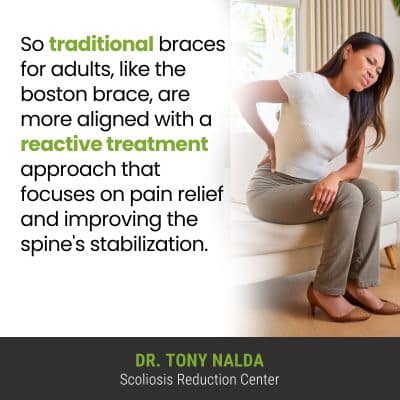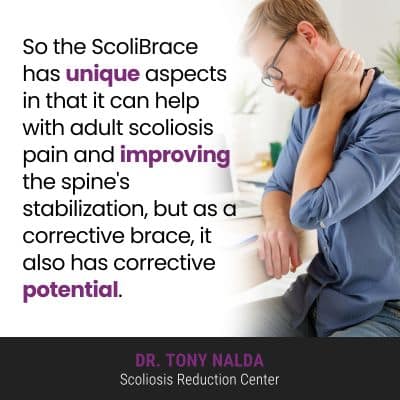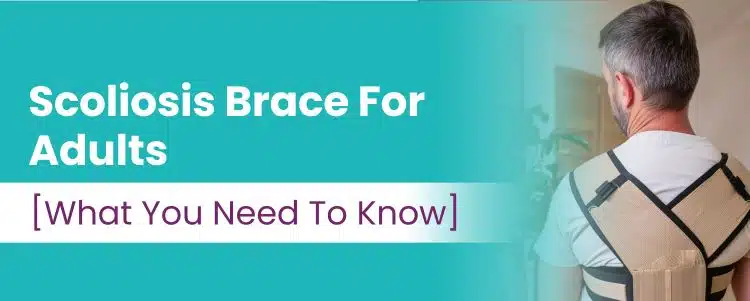Adults and children experience scoliosis differently so have different treatment needs and goals. Scoliosis bracing also has different options as not all braces are created equal, have the same goal, and are equally effective.
Scoliosis braces for adults are mainly used for pain relief and to stabilize the spine, but there is also corrective bracing that has the potential to augment corrective treatment results; however, no brace on its own can treat scoliosis. Bracing needs to be combined with other forms of treatment.
The potential efficacy of a scoliosis brace is shaped by the treatment approach it’s aligned with, and that’s traditional surgical treatment versus modern conservative treatment.
Scoliosis Treatment Goals
There are two main treatment approaches with different end goals: traditional and conservative treatment.
Scoliosis involves the development of an unnatural spinal curve, and the goal of traditional treatment is to stop it from getting worse; scoliosis is a progressive condition whose nature is to get worse over time.
It’s important that patients understand different treatment approaches and different scoliosis braces offer different potential results.
Scoliosis is more commonly diagnosed in children and adolescents, but it also affects adults, and the two main types to affect adults are idiopathic scoliosis and degenerative scoliosis; idiopathic scoliosis is pre existing scoliosis from adolescence, and degenerative scoliosis is also known as de novo scoliosis and can require significant pain relief for chronic back pain.
Scoliosis getting worse means the size of the unnatural spinal curve is increasing, along with the condition’s uneven forces, and their effects.
The goal of traditional scoliosis treatment is to stop the condition from getting worse, but that’s not the same as correcting it on a structural level: the goal of conservative treatment.
Traditional treatment is more reactive than proactive; it doesn’t start treatment as close to the time of diagnosis as possible, doesn’t have a strategy for addressing mild scoliosis, when it’s most treatable, and funnels patients towards invasive spinal fusion surgery.
Prior to a surgical response, the only traditional treatment applied is bracing, and traditional braces are associated with a number of shortfalls.
Traditional Scoliosis Braces
Traditional scoliosis bracing has the end goal of stopping progression; the most commonly-used brace in traditional treatment is the boston brace, and others include the providence brace, wilmington brace, the milwaukee, and the charleston brace.
The boston brace uses a type of 3-point pressure applied to strategic locations along the scoliotic curve, and this intense pressure squeezes the spine into a neutral and straighter alignment.
While squeezing the spine can force it into a straighter position, that level of pressure is known to weaken the spine over time, particularly when prescribed for full time wear.
Scoliosis and Compression

For adults, the boston can be used to stabilize the spine and for short-term pain relief. Scoliosis becomes a compressive condition once skeletal maturity has been reached, and it’s compression of the spine and its surrounding muscles and nerves that causes the majority of condition-related pain.
Pain is the main effect of scoliosis in adults and is what brings them in to see me for a diagnosis and treatment, so pain management is a focus of treatment.
Bracing for adults can increase spinal stabilization, particularly when treating degenerative scoliosis that’s caused by natural age-related spinal degeneration; an adult’s spine can become increasingly unbalanced and unstable.
Keeping the spine stable can help prevent it from getting injured and works towards a better body symmetry.
The boston brace is limited in its potential efficacy because it only addresses scoliosis as a 2-dimensional condition, ignoring its rotational component.
So traditional braces for adults, like the boston brace, are more aligned with a reactive treatment approach that focuses on pain relief and improving the spine’s stabilization.
Modern Corrective Scoliosis Braces
Corrective scoliosis braces represent the culmination of what we’ve learned about scoliosis and bracing efficacy over the years and addresses many of the shortfalls associated with traditional bracing.
Here at the Scoliosis Reduction Center®, my patients benefit from a proactive conservative treatment approach that starts treatment as close to the time for diagnosis, and the end goal of treatment is to correct the scoliosis.
The ScoliBrace is an ultra-corrective brace that offers an over corrective approach to augmenting corrective treatment results facilitated by additional scoliosis-specific treatment disciplines.
While the big response of traditional treatment is spinal fusion surgery when/if a patient progresses into the severe classification, conservative treatment goals are to correct the scoliosis on every level.
The ScoliBrace addresses the shortfalls of the traditional boston brace by:
- Addressing scoliosis as a 3-dimensional condition (impacting the spine’s rotation)
- Pushing the spine instead of squeezing it
The ScoliBrace, as part of conservative treatment, comes with other types of treatment all working towards a common goal: achieving corrective results.
Correcting scoliosis means primarily impacting it on a structural level as the underlying nature of scoliosis is structural, and corrective bracing can compliment chiropractic care that works towards adjusting the position of the curve’s most-tilted vertebrae into a straighter alignment: by pushing the spine into a corrective position.
The Benefits of Corrective Bracing
So the ScoliBrace has unique aspects in that it can help with adult scoliosis pain and improving the spine’s stabilization, but as a corrective brace, it also has corrective potential.
Once the spine’s impacted on a structural level, conservative treatment focuses on increasing core strength so the spine can be optimally supported and stabilized by its surrounding muscles, as a healthy spine is.
Scoliosis doesn’t just affect the spine and its spinal nerves within, but also the spine’s surrounding muscles; a common effect of scoliosis can be the development of a muscular imbalance.

Muscles that surround an unnaturally bent and twisted spine can become unbalanced from being pulled in different directions; muscles on one side of the spine can become stretched from overuse while muscles on the other side can become weak from underuse.
Scoliosis bracing simulates the effect of strong core muscles supporting the spine from both sides.
In the treatment of adolescent idiopathic scoliosis, the most prevalent condition type, the goal of treatment is to achieve a significant curve reduction because growth is the condition’s progressive trigger; in adults, curve progression tends to be slower because their spines are no longer growing.
In many adult scoliosis cases, the goal of treatment is still a curve reduction, but reducing the curve back to where it was prior to becoming painful is the goal, rather than a significant curve reduction to counteract rapid progression caused by a rapid growth spurt.
When combined with other effective facets of corrective treatment, as are applied in a conservative treatment approach, corrective bracing for adults can offer the benefits of correction, pain relief, and spinal stabilization.
No one type of treatment is powerful enough to impact the complex nature of scoliosis on every level, but when combined with other types of scoliosis treatment, corrective bracing can be a valuable facet of adult scoliosis treatment.
Conclusion
So what you need to know about adult scoliosis bracing is that it can help relieve chronic back pain, improve postural balance, spinal stabilization and support, and when bracing is corrective and integrated into a conservative treatment approach, it can also help correct adult scoliosis.
Adult scoliosis behaves differently because once skeletal maturity has been reached, the condition becomes compressive and painful, and this also affects progression: triggered by growth.
Growing spines are more responsive to bracing as a facet of treatment, but bracing can also have a place in the treatment of adult scoliosis, particularly when combined with other types of corrective treatment.
Traditional scoliosis treatment has the goal of stopping progression and uses bracing to squeeze the spine into a straighter alignment, but this can weaken a spine that’s already being exposed to uneven forces and compression.
Conservative scoliosis treatment has the goal of correcting the scoliosis, and this involves addressing its underlying structural nature through reducing the size of the curve, and increasing core strength for spinal support/stabilization through physical therapy.
Physical therapy can increase the strength of the spine’s surrounding muscles, help with postural correction, muscular imbalance, and activating specific areas of the brain for improved brain-body communication.
Bracing can help augment corrective results by pushing the spine into a straighter and more-neutral alignment, complimenting chiropractic care being applied to manually adjust the position of the curve’s most-tilted vertebrae.
So bracing for adults can achieve different things based on the focus of the brace in question, and the traditional Boston brace focuses on stopping progression, but is limited in its potential efficacy for a number of reasons; the ultra-corrective ScoliBrace offers adults with scoliosis corrective potential and addresses many of the Boston’s shortcomings.




